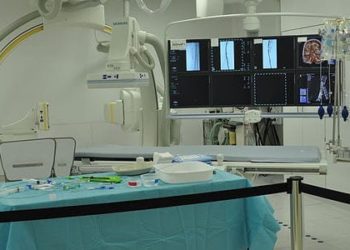Endovascular repair of ruptured AAAs no better than open repair
Image: PD
1. Endovascular aneurysm repair (EVAR) and open repair (OR) repair of ruptured abdominal aortic aneurysms (AAAs) do not have significantly different 30-day mortality rates.
2. EVAR leads to significantly less renal insufficiency, possibly due to lack of suprarenal clamping.
Evidence Rating Level: 1 (Excellent)
Study Rundown: Ruptured AAAs require immediate surgical intervention; traditional OR has an almost 50% mortality. Several observational studies have supported the idea that EVAR could potentially reduce this mortality rate. This multi-center trial randomized ruptured AAA patients to EVAR or OR, and assed a composite of death and severe complications at 30 days: the rate of this primary endpoint was 42% in the EVAR group and 47% in the OR group, representing no significant difference. There were overall fewer complications in the EVAR group, though renal insufficiency was the only complication to reach statistical significance. This study is the largest randomized ruptured AAA trial to date, with excellent follow-up. However, the relative lack of center EVAR experience coupled with an unexpectedly low OR mortality may have skewed the results. While it does not look like EVAR is currently a better method of ruptured AAA repair, newer generations and increasing center experience may provide better results.
Click to read the study in Annals of Surgery
Relevant Reading: A systematic review and meta-analysis of endovascular repair (EVAR) for ruptured abdominal aortic aneurysm
In-Depth [multi-center randomized controlled trial]: Of 520 ruptured AAA patients presenting between 2004 and 2011, 116 patients suitable for both EVAR and OR were randomized to one of the two interventions to be performed at three trial centers. An aorto-uni-iliac endograft with a contralateral iliac occluding device was used for the EVAR procedures; OR treatment comprised midline laparotomy and exclusion of aneurysm by either a polyester tube or a bifurcated graft. Combined death and severe complications at 30 days were 42% in the EVAR group versus 47% in the OR group (no significant difference). 30-day mortality was 21% in EVAR and 25% in OR, and no significant differences in mortality between the treatment groups emerged at any later point. Moderate and severe renal insufficiency occurred less often in the EVAR group (6 vs. 18 patients, ARR=20%). EVAR patients experienced shorter hospital stays, fewer and shorter ICU admissions, needed less mechanical ventilation, and had significantly lower blood loss during surgery. 14% of EVAR patients converted to OR intraoperatively, which likely contributed to poor EVAR outcome.
By Mariya Samoylova and Allen Ho
More from this author: Transfusion worsens outcomes for HCV+ liver transplant recipients
© 2013 2minutemedicine.com. All rights reserved. No works may be reproduced without expressed written consent from 2minutemedicine.com. Disclaimer: We present factual information directly from peer reviewed medical journals. No post should be construed as medical advice and is not intended as such by the authors, editors, staff or by 2minutemedicine.com. PLEASE SEE A HEALTHCARE PROVIDER IN YOUR AREA IF YOU SEEK MEDICAL ADVICE OF ANY SORT.




![The ABCD2 score: Risk of stroke after Transient Ischemic Attack (TIA) [Classics Series]](https://www.2minutemedicine.com/wp-content/uploads/2013/05/web-cover-classics-with-logo-medicine-BW-small-jpg-350x250.jpg)

